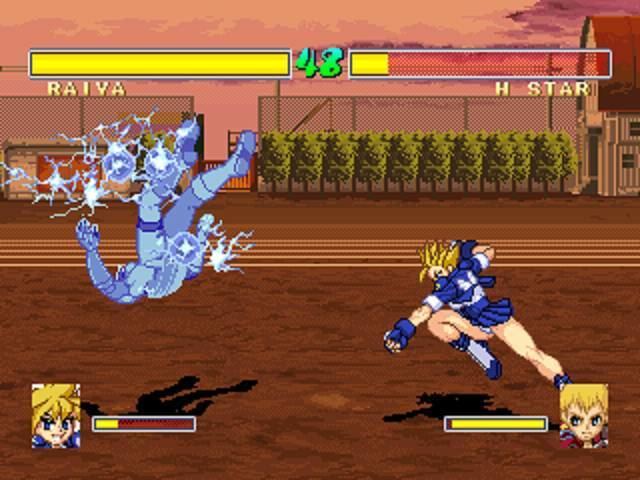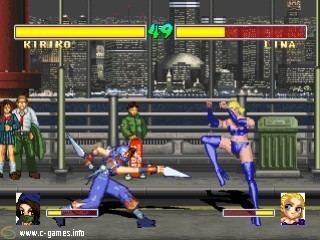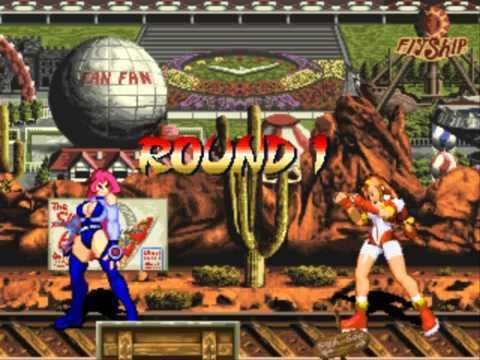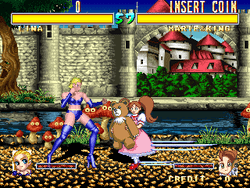9.2 /10 1 Votes
Composer(s) Takuya Hanaoka Initial release date 1996 | 4.6/5 Emuparadise Cabinet Horizontal Developer Tecmo CPU Motorola 68000 (@ 16 MHz) | |||||||||||||||||||||||||||||||||
 | ||||||||||||||||||||||||||||||||||
Mode(s) Single player, 2-player Arcade system Tecmo Mother Board System Sound Sound CPU : Z80 (@ 8 Mhz)Sound Chips : YMF262 (@ 14.31818 Mhz), OKI6295 (@ 2 Mhz), YMZ280B (@ 16.9 Mhz) Display 336 x 256 pixels, 2049 colors Similar Tecmo games, Fighting games | ||||||||||||||||||||||||||||||||||
Tōkidenshō Angel Eyes (闘姫伝承 ANGEL EYES, Tōkidenshō Enjeru Aisu, "Fighting Princess Legend - Angel Eyes") is a fighting video game developed and published by Tecmo for the arcade game market in 1996. It was later ported to the PlayStation game console, being released on December 11, 1997; in 2009, it has been also made available as downloadable content in the PlayStation Store, for the PlayStation 3 and the PSP. Both the original arcade version and the PS version were released in Japan only, and the downloadable version for PS3 and PSP remains in Japanese language.
Contents

Angel Eyes featured an all-female character roster, in the same way as other fighting games with all-female rosters like Metal & Lace: Battle of the Robo Babes, Variable Geo, Seifuku Densetsu Pretty Fighter, Arcana Heart and Asuka 120%. In a similar way to Capcom's Justice Gakuen series, most of the characters were teenage students fighting for the honor of their school and to earn the right of becoming the Great Angel. The game sported very high-quality, manga-styled character artwork, vigorous animation and attractive backgrounds. Contributing to the game's uniqueness, its visuals combined two-dimensional and three-dimensional graphics. Angel Eyes has remained mostly in obscurity in the West, due to not being released outside Japan. In Japan however, it gained a moderate success and following, and is still being used in tournaments there.

Storyline

The game's storyline takes place in Japan. The substance of an angel from heaven was sent to Earth to incarnate in a human. However, there are eight girls holding the potential to become the host of the angel's substance. Therefore, who is worthy of inheriting the substance is to be she who proves herself the strongest in battle.
Gameplay
Tōkidenshō Angel Eyes was as most fighting games of its day, a two-dimensional and sprite-based (although some of the characters were pre-rendered, that interacted with the hand-drawn, sprite based characters), one-on-one fighting game, and the objective for the player was to advance by defeating the opponent by winning two rounds out of three in competitive matches.

Following the traditional template of fighting games, the characters had at their disposal and arsenal of normal martial arts moves varied by the characters' posture, complemented by special moves endowed with additional power or abilities. The game also featured certain gameplay mechanics that although by today standards are commonplace, were rather unusual and innovative back at the time of its release, such as a mid-air dash, mid-air suspension, mid-air chase capabilities, a homing jump, high jump, and a special ability trigger called Angel Synchro.
Characters

The characters were designed following several typical anime-style stereotypes. Some of them attend the Saintly Tehkan Academy (聖・テーカン学園, Hijiri Tēkan Gakuen), named after Tecmo's former company name. They ranged from a hot-blooded schoolgirl to a kunai-wielding teenage kunoichi. The basic roster is as follows:
Ports and related releases
The arcade game was later ported to the Sony PlayStation on December 11, 1997. This version included eight additional characters, which were mainly modified, palette swapped versions of the original characters, with special capabilities. The characters were unlocked by meeting certain requirements during gameplay, they are listed as follows: Bin Chibiko, Black Raiya, Hyper Mysterious Power, Lina 2, Maria & Panda, Robo Chibiko, Wounded Highway Star and Akane. The Story mode in this version also further explored the plot. On March 31, 2009, the PlayStation version was re-released through the PlayStation Network.
To promote the game in Japan, Tecmo released an album containing artwork of the characters as well as a music CD containing the game soundtrack. Also, a Drama CD titled Tōkidenshō Drama Album (闘姫伝承ドラマ・アルバム, Tōkidenshō Dorama Arubamu, Drama Album of the Legend of the Princesses of Battle), was released in the late 90's, containing songs and storyline narrative.
